If you missed parts one and two on SEO, just a quick note to catch you up on what we’re doing here. The digital marketing world is riddled with jargon, acronyms, and other terminology that might be confusing for some. Many of our peers assume that you know what we’re talking about when, in fact, you do not have a clue.
So, Alex and I have taken on the herculean task of defining the terms you need to know and telling you why we think you need to know them. Instead of doing the standard painfully long glossary, we’re going to break it out into disciplines. This way, you can skip right to what you need to know.
In this part, we will focus on PPC (pay-per-click advertising). Here are the links to SEO, Part One and SEO, Part Two.
PPC – Paid Search and Social
PPC (pay-per-click) is an all-encompassing term that covers paid search, social, and paid advertisements and content on target websites. PPC is an effective way to quickly boost traffic by targeting a very specific audience by bidding on the keywords they would use to find you.
PPC allows advertisers to place ads on search engines, social media platforms, Amazon, Walmart, etc. Marketers only pay when a user clicks on the ad.
Here are some PPC terms that marketers should know:
Ad Copy (Ad Creative)
Literally, the text and images used in an ad to promote a product or service. Creative refers to any ads that require a designer to develop a visual ad, including a headline, copy, and images.
Why do you need to know?
Your in-house marketer or outsourced digital marketing agency will reference this when asking for the content of your ad. You’ll want to make your ad copy/creative visually appealing and written in a way to entice a user to click through to a landing page (see below).
Ad Extension
Additional information or links that can be included in an ad, such as a phone number, address, call-to-action button, or product pricing.
Why do you need to know?
Your ad needs to contain some way for the user to act. Sometimes this is a click-through event; other times, they will use the extension information in the ad to contact you, like a phone number or address. An ad extension can also include product pricing or other information to entice action.
Ad Format
Ad format refers to how an ad will appear and where it will be located. Each advertising platform offers several ad formats to choose from. For instance, on Facebook, you can use photos, videos, stories, carousels, slideshows – and the list goes on!
Why do you need to know?
You need to understand the ad format to produce the appropriate ad copy and creative. It is important to test various ad formats to pick the most effective ones.
Ad Group
A collection of ads that share a common theme or target a specific set of keywords. An example theme should be a product or service type.
Why do you need to know?
Ad groups are simply a way to organize and target groups of ads by theme or target keywords to ensure that they are relevant and effective for what they promote and who they are targeting.
Ad Impression
The number of times an ad is shown to a user, whether or not they interact with it. In other words, the number of times an ad has been displayed.
Why do you need to know?
Ad impressions are a key metric to track as they tell you whether a campaign is reaching its target numbers. If impressions are low, targeting parameters may need to be adjusted to reach a larger audience.
Ad Network
A group of websites or apps that display ads to users, such as the Google Display Network, Facebook Audience Network, Amazon Advertising, and others.
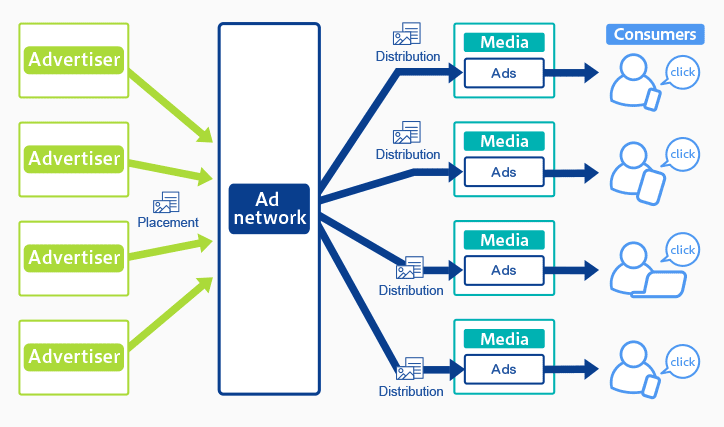
Why do you need to know?
It’s important to understand the ad network options available when building an ad campaign. For example, some may consider Facebook for ads because of familiarity but overlook something like Amazon, an excellent ad network for selling products.
Ad Placement
The location where an ad is displayed on the page where it is running, such as in the news feed of a social network or the top results on the search engine results page.
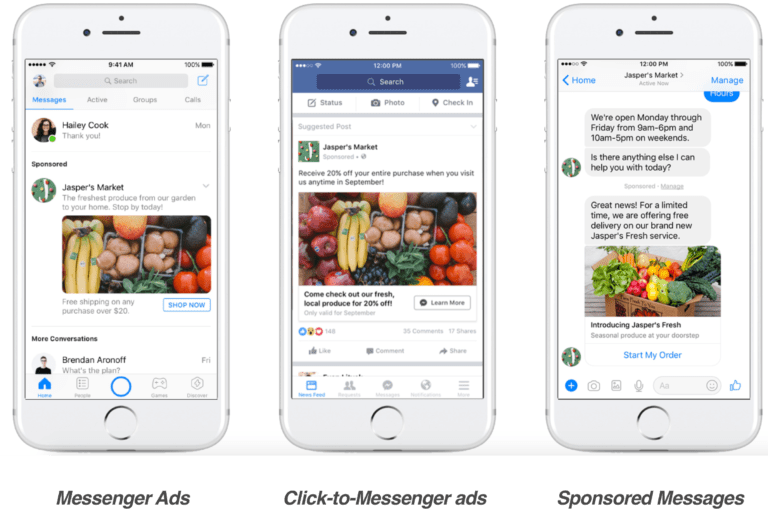
Why do you need to know?
Ad placement is important to consider because it plays a major role not only in the visibility of an ad but also in terms of the user experience and even performance. Context also matters with ad placement in terms of what it will appear near and how that may affect its performance.
Ad Position
Related to ad placement, ad position refers to the hierarchical location of the ad on the website or app, with a more prominent position being preferred but also generally more expensive.
Why do you need to know?
Ad placement is important to understand and plan for as it can directly impact an ad’s visibility and, ultimately, its success. A well-positioned ad can increase the chances of a business reaching its target audience and will impact the ad’s conversion rates.
Ad Rank
A value that determines where an ad will appear on the search results page. Ad Rank is a calculation of the bid amount, ad relevance, landing page quality, and other factors. It is recalculated each time an ad appears.
Why do you need to know?
Marketers need to keep a deliberate and constant eye on ad rank as it will determine things like ad position and impact the effectiveness of the ad. Since it changes each time an ad appears, it is important to make necessary adjustments if the ad rank declines.
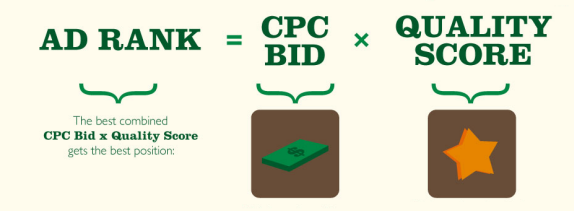
Ad Rotation
The method used to determine which ads in an ad group are shown more frequently. It is the practice of showing multiple ads on a single page or app listing.
Why do you need to know?
If you are running multiple ads in an ad group, it’s important to consider the rotation of those ads. Ad rotation can help with ad fatigue by showing the ads in different places for each page view. Ad rotation can also provide valuable data regarding which ad placement performs the best.
Ad Scheduling
Ad scheduling is as it sounds, the scheduling of an ad’s appearance for different times and days.
Why do you need to know?
Scheduling your ads should be based on user intent, habits, and conversion trends. Google ad campaigns are set to show “All Day” by default, which may not be ideal for your campaign.
Ad Status
Whether an ad is approved, disapproved, pending review, or has been removed.
Why do you need to know?
You may have set your ad to run and then decided to “let it run.” Well, if it is disapproved, pending review, or removed, you have no ad running. Pay attention to the ad status so you don’t have an egg on your face when you report that an ad you thought was running is actually not.
Amazon Marketing Services (AMS)
Amazon’s advertising platform where advertisers can display ads on Amazon.com and its associated properties.
Why do you need to know?
AMS is a platform where you can reach one of the largest groups of shoppers in the world. If selling products is your goal, you should seriously consider using AMS.
Application Program Interface (API)
APIs are a set of tools used for building software applications. In online advertising, APIs allow advertisers to interact with advertising platforms programmatically.
Why do you need to know?
Advertisers can optimize their advertising strategies and help to improve campaign performance with APIs. They allow increased access to detailed and real-time data, which can inform. APIs can also be used to build custom reporting dashboards and integrate them with other marketing tools.
Audience Targeting
The process of selecting specific groups of users to show ads to based on their demographics, interests, and behavior.

Why do you need to know?
This is basic marketing; know your audience. It matters because the alternative is to blindly run campaigns based on the automated settings, leaving your campaign to machine learning and AI, which are not always to your benefit. Let audience data points inform your campaigns in terms of the platform, copy and creative, and timing.
Automated Extensions
Ad extensions the ad platform automatically generates based on an advertiser’s account activity. They can include things like seller ratings, call extensions, location extensions, and site link extensions.
Why do you need to know?
These can be helpful but pay specific attention to what these extensions look like and how they perform. Again, blindly following the suggestions of the tools can be a time saver but can also negatively impact your campaign if they’re not working in your favor based on the KPIs your team has set.
Automatic Bidding
A bidding strategy where the advertiser sets a target cost per click (CPC), and the platform automatically adjusts bids based on the likelihood of a click or conversion.
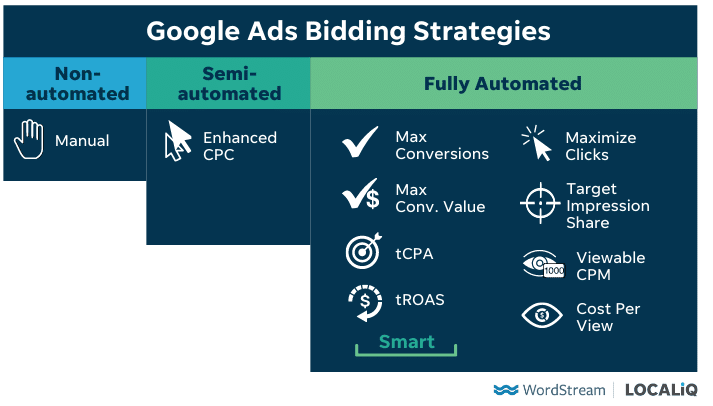
Why do you need to know?
Automated bidding can improve ad efficiency, performance, and flexibility by using real-time data to adjust ad spend. It can also provide valuable data about campaign performance that can inform future advertising and bidding strategies.
Just be sure to pay attention in case the bidding is not working in your favor for whatever reason.
Automatic Placements
A targeting option within Google Ads where ads are automatically placed on websites, videos, and apps based on the targeting criteria provided.
Why do you need to know?
Let’s face it: we don’t know all the advertising platforms and opportunities available to us. This feature can help you to reach your target audience in places you may have never considered. Once again, though, pay attention and make adjustments if your campaign appears in places you might not want it to.
Average Cost-Per-Click (Average CPC)
Average CPC is the average amount an advertiser pays per click on their ad, which can be used to inform budget decisions.
Why do you need to know?
Money is important, especially in marketing, and so is ROI, especially in advertising. Average CPC data can help to set your budget, bid management, and ad performance baselines. And this data is also helpful when determining the ROI of a campaign.
Average Position
A metric that indicates the average ranking of an ad on a SERP in relation to other ads. A position of 1 means the ad is in the top place, while 2 or lower means the ad appears lower on the page.
Why do you need to know?
This data helps you to evaluate an ad’s performance, improve visibility, adjust bidding strategies, and increase ad rank.
Bidding Types
Bidding types refer to the different strategies advertisers can use to bid on ad placements, such as manual bidding, automatic bidding, and target return on ad spend (ROAS) bidding.
Why do you need to know?
Diversifying your campaign strategies can help maximize your effectiveness and greatly inform decisions about future campaigns. By utilizing different bidding types, you can determine the most effective ones and use that knowledge to make future campaigns efficient and successful.
Bing Ads
Bing Ads is Microsoft’s PPC advertising platform that allows advertisers to display ads on Bing and Yahoo search results pages.
Why do you need to know?
Bing ads may offer a lower cost-per-click than Google for specific keywords while being a much less competitive space to advertise in. That said, Google has a clear advantage in terms of audience size, so make sure you’ve accounted for that when deciding whether to run Bing ads.
Broad Match
A Google Ads targeting option that allows the platform to display ads for searches that include the advertiser’s keywords and related terms and variations.
Why do you need to know?
Broad match targeting allows advertisers to increase reach and visibility, especially those with limited experience running ads. That said, it can also be risky, resulting in irrelevant clicks and wasted ad spend if not monitored and managed carefully.
Broad Match Modifier (BMM)
A targeting option within Google Ads to specify certain keywords that must be included in the user’s search query for their ad to be displayed.
Why do you need to know?
Broad match modifiers allow marketers to expand their reach while maintaining more control over the types of search queries that trigger their ads. This lets you expand your reach to a broader audience without risking irrelevant clicks and wasted ad spend.
Call Extensions (also known as Click-to-Call)
Ad extensions (see above) that allow users to click on a number displayed in the ad to immediately call the advertiser.
Why do you need to know?
Call extensions are a useful advertising tool if contact by phone is a desired user action. If phone calls are the target outcome, then you will definitely want to use call extension as opposed to simply placing the number in the ad copy so you can track conversions accurately.
Callout Extensions
Ad extensions that allow advertisers to add additional text to their ads to highlight specific features, price details, or benefits of their product or service.

Why do you need to know?
These are different from automated extensions in that you can manually add these. Callout extensions can be added to your whole account (this way, the extension will show on all your ads), a specific campaign, or an ad group.
Change History
Change history is a feature within Google Ads that allows advertisers to view a log of changes made to their account, such as campaign settings, ad copy, and bids.
Why do you need to know?
This is a useful tool if you are not keeping notes as to changes in copy, creative, budget, timing, etc. If you have multiple campaign managers, not recommended in most cases, it may also be useful to know exactly when a change was made and by whom. It’s the ad platform’s little narc. 😉
Click-Through Rate (CTR)
The ratio of clicks to impressions. CTR indicates how often people who view an ad end up clicking on it, as well as the effectiveness of an ad.
Why do you need to know?
CTR is a common KPI as it measures the number of clicks an ad receives, which can, in most cases, indicate the overall effectiveness of the ad. Of course, if the clicks do not produce an equally impressive conversion rate (see below), that can indicate an issue with the ad copy, audience targeting, and other campaign settings.
Conversion Rate
The percentage of users who take a desired action, such as making a purchase, filling out a form, scheduling a meeting, and so forth, after clicking on an ad.
Why do you need to know?
Clicks are a vanity metric only if they do not result in conversions. The conversion rate of an ad campaign is the metric used to determine campaign ROI unless the campaign’s sole purpose is visibility.
Cost Per Acquisition (CPA)
How much an advertiser pays for each conversion, such as a sale, signup, call, or form submission.
Why do you need to know?
This is how you determine the actual cost of acquiring a customer through your ad campaign. The CPA accounts for all campaign costs, including ad spend, targeting, creative, etc. This is a key component of campaign optimization.
Cost Per Click (CPC)
How an advertiser pays each time a user clicks on their ad. CPC is determined by the bid amount and the competitiveness of the keywords.
Why do you need to know?
Similar to CPA but not necessarily as valuable, this metric can inform your bidding strategies moving forward, as well as the overall effectiveness of your ads. Just remember to look at the cost per acquisition and the conversion rates.
Cost-Per-Lead (CPL)
A pricing model where advertisers pay for each lead generated by their ad, such as a completed form, download, or sign-up.
Why do you need to know?
Sometimes the point of a campaign is to generate leads for your sales team. If so, this is an important metric to account for, specifically when measured against your sales team’s close rate (the number of leads converted to a sale).
Cost-Per-Phone Call (CPP)
A pricing model where advertisers pay for each phone call generated by an ad in their campaign.
Why do you need to know?
Similar to CPA and CPL, if a phone call is your target conversion, then you will certainly want to pay attention to this metric.
Cost Per Thousand (CPM)
The amount an advertiser pays for every thousand ad impressions.
Cost-Per-View (CPV)
Cost-per-view is a pricing model used in video advertising in which advertisers pay for each view of their ad.
Why do you need to know?
This is an important metric if the purpose of your campaign is awareness. Otherwise, is it less important than other metrics related to user action.
Daily Budget
The maximum amount of money an advertiser is willing to spend on their campaign per day.
Why do you need to know?
Tracking your ad performance against your daily spend can help you to incrementally adjust your overall budget as needed.
Display/Content Network (Google Display Network)
This is a group of websites and apps where you can display ads. This is a group of over 2 million websites, videos, and apps that Google has grouped into one platform called the Google Display Network).
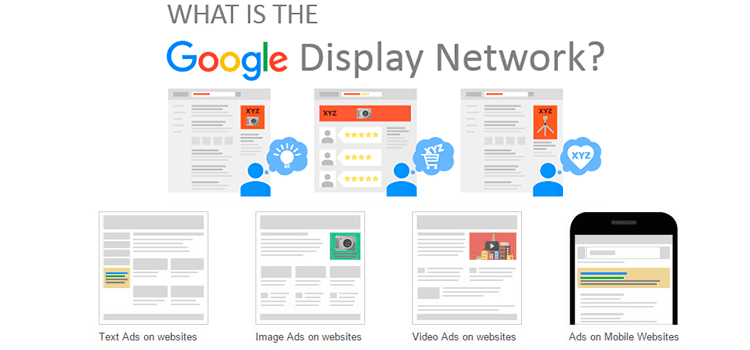
Why do you need to know?
Display networks allow marketers to display visual ads to a large audience (Display Networks reach over 90% of Internet users globally). These networks offer marketers access to a large audience that can be targeted based on things like demographics, interests, and behaviors.
Display URL (Final URL)
The web address that is displayed in an ad, typically in a smaller font than the destination URL. This URL is visible to the user and gives them an idea of where they will go when they click. The display URL may differ from the destination URL (see below).
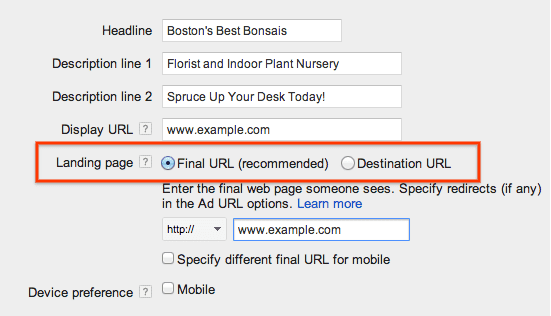
Why do you need to know?
Make your display URL a clear and obvious link that does not try to trick the user. A display URL that is misleading or unclear may result in fewer clicks, as users may not trust the website they are being directed to.
Destination URL
This is the actual web address of the page (landing page) that your ad is directing clicks to. This needs to match the link address (where the display URL takes the user when clicked) for the display URL (see above).
Why do you need to know?
The destination URL is the place where a click could lead to a conversion. Be certain to test that this link works, is the place you want people going to when they click, and is optimized for mobile users and for conversion.
Dynamic Ad Targeting
A targeting option within Google Ads where automatically generated ads are shown to and personalized for each user based on their interests, demographics, and other data.
Why do you need to know?
These highly personalized ads are more likely to resonate with your target audience and can lead to higher engagement, more clicks, and, ultimately, more conversions.
This requires careful planning, execution, and a deep understanding of the target audience and their buying journey. You’ll want to continually monitor and optimize these campaigns to ensure that they are delivering the best possible results.
Dynamic Keyword Insertion (DKI)
A Google Ads feature that changes ad content to match a search query, improving the relevance and effectiveness of a paid search campaign.
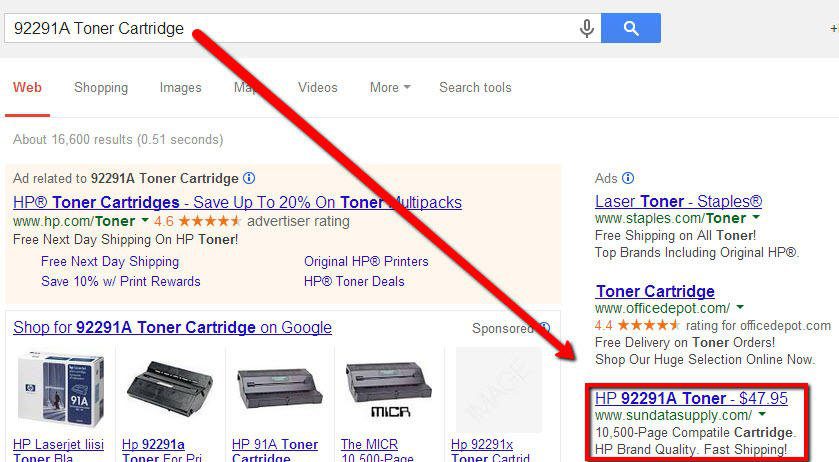
Why do you need to know?
DKI can be used to improve the relevance of your ads to the user’s search query, which can result in an increased click-through rate (see above). That said, you will want to be strategic and thorough using DKI, ensuring the ads remain grammatically correct and coherent for the user.
Engagement
The actions that users take in response to ads. This could be likes or shares on social media and views or watching time on video.
Why do you need to know?
While engagement is not conversion, and conversion is usually your number one goal, good engagement can still be an indicator that your ad creative and content are appropriate and attractive to your target audience.
Enhanced CPC (ECPC)
A Google Ads bidding strategy that uses machine learning to automatically adjust bids based on the likelihood of a user converting. It can also help keep bidding costs under control while providing a better conversion value.
Why do you need to know?
ECPC is a very effective bidding strategy that, if done correctly, can result in increased conversions and better ROI. The better ROI directly results from optimizing bid costs and increasing the conversion rate.
That said, you will want to monitor your campaign closely in case the inverse happens and your bid costs go up. Everything that an ECPC offers can potentially happen in reverse, so be mindful of that and keep a close eye on your campaigns.
Facebook Ads
Facebook’s advertising platform where advertisers can display ads on the Facebook and Instagram platforms.
Why do you need to know?
Not rocket science on this one. Facebook and Instagram are popular platforms and potential places to run ads if your target audience has a substantial presence there. And your C-suite is NOT your target audience. Don’t run ads on platforms simply because a decision-maker at your organization spends time there.
Frequency Capping
A setting in advertising platforms that limits the number of times a user sees a particular ad over a certain period.
Why do you need to know?
This technique can be useful for avoiding ad fatigue and can help you to limit who sees the ad and how many times they see it. It can improve your ad targeting by showing the ad to a wider range of people instead of over and over to the same individuals.
Geotargeting
A targeting option within advertising platforms where advertisers only display their ads to users in specific geographic locations.
Why do you need to know?
Geotargeting is a great way to target very specific locations and avoid running ads in places where you either do not want to do business or simply cannot do business.
Google AdWords
The original name of Google’s advertising platform, which has since been rebranded as Google Ads.
Why do you need to know?
If you hear someone reference Google AdWords, then you know they are talking about Google Ads and have likely been doing this for a while.
Google Forwarding Number
A feature within Google Ads that assigns a unique phone number to an ad so they can track phone calls generated by the ad.
Why do you need to know?
If phone calls are your main conversion goal or one of them, then you will definitely want to track these calls. A Google Forwarding Number is a great option for gathering call data and tracking the conversion rate of your ad.
Google Merchant Center
A tool that allows retailers to upload and manage their product data for use in Google’s shopping ads (formerly Product Listing Ads).
Why do you need to know?
This is a great way to show your products directly to Google users, allowing them to browse products right in the SERPs. It increases your reach and may drive more qualified traffic to your site and increase conversions.
You’re Getting PPC-Smarter!
This concludes part one of our essential PPC terms definitions. You are halfway on your way to a better understanding of PPC and the terms used when discussing it.
Thanks for joining us as we embark on our epic journey of digital marketing discovery! Ensure you don’t miss part two; sign up for our mailing list!